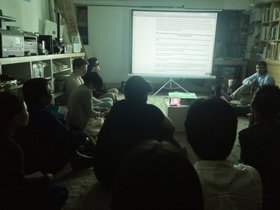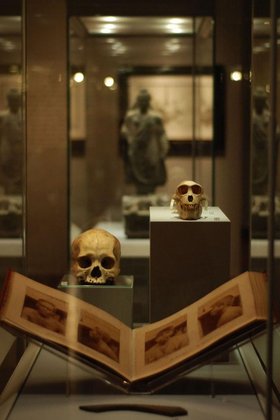Reviews
CAMPING AND TRAMPING THROUGH THE COLONIAL ARCHIVE
A Talk and Screening by Shabbir Hussain Mustafa
Archive fever came back to Hong Kong this Spring. Shabbir Hussain Mustafa, curator of the National University of Singapore Museum, recently presented a lecture titled 'Camping and Tramping through the Colonial Archive' at Para/Site Art Space (27th March 2013) as part of a residency initiated by the non-profit in Hong Kong. In the talk, Mustafa focused on exhibitions he has been involved in, including Camping and Tramping through the Colonial Archive: The Museum in Malaya (2011) and Prep Room | Things That May or May Not Happen (2012). Mustafa's lecture presented an assemblage of images and texts tied into an archival-curatorial practice through which a multitude of post-colonial discourses have been produced. The investigation explored material archives while redefining the museum as a signifier of the public sphere.
Looking at the 'social history of art' instead of 'art history', Mustafa's lecture unfolded like a journey through curatorial projects in the NUS Museum. Images presented documented rock-textured fish specimens in a glass case imitating their own past lives and traditional Indian sculptures attempting to recall the architecture of the structures in which they resided. The curator also screened several films from Malaya Black and White[1], a cumulative online archive of moving images harbouring a prism of representations of the concept of 'Malaya' during the colonial years, from sources including Hollywood movies and propaganda films. The screening was punctuated by propaganda narrations promoting a new world in need of a new concept of citizenship and the nation-state. Laughter occasionally erupted from the audience. As it would seem, explicit propaganda can only exist as a joke today.
Documentation displayed at Mustafa's presentation shed some light on the possibilities of mapping the post-colonial hetero-temporalities of modernity through museological research into colonial archives of artefacts. In Mustafa's projects, the pursuit of a new discursive totality to absorb the assembly of objects is avoided. Instead, he emphasises the creation of 'openings' in existing historical discourses.The exhibition Archives and Desires (2008), also presented in Mustafa's talk is particularly pertinent here, as it implemented a museological examination surrounding the properties of archives and display cultures. This was enacted through an exploration of the house of Singaporean artist Mohammad Din Mohammad (1955-2007), considered a natural healer after healing his own gangrene. This connection is represented in such works as Earth Energy II(1994) – a matrix constructed of bones and plants with supposedly medical properties. The artist's later practice is further characterised by a spiritual dimension related to Sufism and Zikr – including the forms of Qur'anic recital – as is the case with Alif Lam Min(2003), an acrylic-on-paper painting depicting the opening fragments of the Qur'an.
It can be very seductive for researchers working on post-colonial archival curatorial projects to demarcate the order of things into the dichotomies of rational/ irrational, self/other and barbaric/ civilized. Archives and Desires must have also been faced with this temptation. Mohammad Din Mohammad's practice certainly involved elements that could be misunderstood as merely 'exotic'. However, Mustafa successfully avoided this by encouraging readers to experience the objects in real time. The power to interpret an archive is released to the viewers through a fissure produced by immediacy, allowing the audience to experiences objects from a sensory perspective rather than locating them in the totality of an existing colonial narrative.
But as a possible mode of post-colonial discursive formation, Mustafa's projects demonstrate an emphasis on the accumulation of objects perhaps based on the conventional conceptions of museums and archives – the signification of death separated from a living, pre-institutionalized reality: an exciting 'outside' beyond the walls. The cumulative strategy allows a collapse of the dialectics of inside/outside, and a sense that the assembly of things is not another staging of a subject/object rivalry. Instead of allowing artifacts to fall victim to another hegemonic reduction – that of certain post-colonial discourses or relations with human activities – Archives and Desires evokes a dingpolitik,when 'matter of fact' gives way to 'matter of concern', something that emerges from the complaint against the way objects are muted in politics, where non-human actants co-produce society.
In this, Mustafa's talk and screening ultimately presented howexplorations into archives thus take up the task of demarcating the cultural landscape of the museum as a public institution (in this case the National University of Singapore Museum) in an era characterised by the crisis of political and artistic representation. The event was inspiring. An archival curatorial practice like Mustafa's allows imaginations about things assembled in a visible world to exist neither as residues of past human activity and inter-subjectivity nor as bundles of physical properties. This induces contemplation, not only on the archive, but also on how objects – perhaps playing the role of the Heideggerian 'broken-tool', an object once suffocated by networks of references now emancipated by the disruption of referential context so as to(re)construct the discursive spatiality of an art institution.
Yet an expectation of linkage in the post-colonial museological research between Singapore and Hong Kong – both former British colonies – may have gone unnoticed. Perhaps this is because Hong Kong is not ready for a post-colonial account of cultural production: a recent survey by the South China Morning Post tells us that more than 90% of Hong Kong people would like to return to the coloniser.
For more information, visit www.para-site.org.hk.
[1] This particular project recalled a key figure inspiring 'Camping and Tramping' – Ivan Polunin, a British physician and part-time documentary cinematographer from 1950-1973, who produced a vast collection – almost 100 hours – of moving images from Singapore with his 16mm camera, providing an extensive visual archive to be explored.







